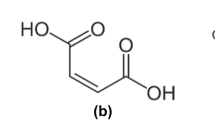Abstract
This paper describes a hydrometallurgical process for recovering neodymium (Nd) and dysprosium (Dy) from a magnetic waste sludge generated from the Nd–Fe–B(–Dy) manufacturing process. Phase analysis by XRD study revealed Nd(OH)3 and Fe2O3 as main mineral phases, and chemical analysis by ICP showed the contents of 35.1 wt% Nd, 29.5 wt% Fe, 1.1 wt% Dy and 0.5 wt% B. A solution of 1 M HNO3 + 0.3 M H2O2 was used to dissolve up to 98 % Nd and 81 % Dy, while keeping Fe dissolution below 15 % within 10 min. Fe dissolved in solution was completely removed as Fe(OH)3 at pH 3 followed by precipitation of Nd and Dy with oxalic acid (H2C2O4) and recovered 91.5 % of Nd and 81.8 % of Dy from solution. The precipitate containing Nd and Dy was calcined at 800 °C to obtain Nd2O3 as final product with 68 % purity, and final recovery of 69.7 % Nd and 51 % of Dy was reported in this process.









Similar content being viewed by others
References
Miura K, Itoh M, Machida K (2008) Extraction and recovery characteristics of Fe element from Nd–Fe–B sintered magnet powder scrap by carbonylation. J Alloys Comp 408–421:1391–1395
Itoh M, Miura K, Machida K (2008) Novel rare earth recovery process on Nd–Fe–B magnet scrap by selective chlorination using NH4Cl. J Alloys Comp 477:484–487
U.S. Geological Survey Fact Sheet 087–02. (http://www.cr.usgs.gov)
Takeda O, Okabe TH, Umetsu Y (2006) Recovery of neodymium from a mixture of magnet scrap and other scrap. J Alloys Comp 408–412:387–390
Rare metal news, vol 2180. Arumu Publish Co., Tokyo (2004)
Takeshi I, Ryo S, Hideaki I (2006) Resource recovery from Nd–Fe–B sintered magnet by hydrothermal treatment. J Alloys Comp 408–412:1382–1385
Saito T, Sato H, Ozawa S, Yu J, Motegi T (2003) The extraction of Nd from waste Nd–Fe–B alloys by the glass slag method. J Alloys Comp 353:189–193
Saito T, Sato H, Motegi T (2006) Recovery of rare earths from sludges containing rare-earth elements. J Alloys Comp 425:145–147
Horikawa T, Miura K, Itoh M, Machida K (2006) Effective recycling for Nd–Fe–B sintered magnet scraps. J Alloys Comp 408:1386–1390
Murase K, Machida K, Adachi G (1995) Recovery of rare metals from scrap of rare earth inter-metallic material by chemical vapor transport. J Alloys Comp 217:218–225
Miura K, Masuda M, Itoh M, Horikawa T, Machida K (2006) Microwave absorption properties of the nano–composite powders recovered from Nd–Fe–B bonded magnet scraps. J Alloys Comp 408–421:1391–1395
Saguchi A, Asabe K, Fukuda T, Takahashi W, Suzuki RO (2006) Recycling of rare earth magnet scraps: carbon and oxygen removal from Nd magnet scraps. J Alloys Comp 408–412:1377–1381
Xu Y, Chumbley LS, Laabbs FC (2000) Liquid metal extraction of Nd from NdFeB magnet scrap. Mater Res 15:2296–2304
Lever FM, Payne JB (1967) Separation of rare-earth and production of the metals. In: Advances in extractive metallurgy. Proceedings of symposium. IMM, London
Morrison JW, Palmer GR (1990) Recycling of metals and engineered materials. Second Int Symp 28(31):593–609
Jiang Y, Shibayama A, Liu K, Fujita T (2004) Recovery of rare-earths from the spent optical glass by hydrometallurgical process. Can Metall Q 43(4):431–438
Preston JS, Cole PM, Craig WM, Feather AM (1996) The recovery of rare-earth oxides from a phosphoric acid by-product. Part 1: leaching of rare-earth values and recovery of a mixed rare-earth oxide by solvent extraction. Hydrometallurgy 41(1):1–19
Preston JS, Cole PM, Du Preez AC, Fox MH, Fleming AM (1996) The recovery of rare earth oxides from phosphoric acid by-product, part 2. The preparation of high purity cerium dioxide and recovery of a heavy rare earth oxide concentrate. Hydrometallurgy 41(1):21–44
Pat. No. 3,311,449 issued Mar. 28 (1967)
Pat.No.3, 574,537, issued Apr. 13, (1971)
Ritcey GM, Ashbrook AW, (1979) Principles and application to process metallurgy. Solvent Extr Part 2:386–420
Canning RG (1961) The recovery and separation of scandium, yttrium, thorium and lanthanides by solvent extraction. Proc Aust IMM 198:113–151
Author information
Authors and Affiliations
Corresponding author
Rights and permissions
About this article
Cite this article
Rabatho, J.P., Tongamp, W., Takasaki, Y. et al. Recovery of Nd and Dy from rare earth magnetic waste sludge by hydrometallurgical process. J Mater Cycles Waste Manag 15, 171–178 (2013). https://doi.org/10.1007/s10163-012-0105-6
Received:
Accepted:
Published:
Issue Date:
DOI: https://doi.org/10.1007/s10163-012-0105-6



